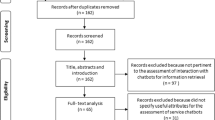Abstract
This paper presents a concept of adaptive development of user interfaces in multimodal web-based systems. Today, it is crucial for general access web-based systems that the user interface is properly designed and adjusted to user needs and capabilities. It is believed that adaptive interfaces could offer a possible solution to this problem. Here, we introduce the notion of the user profile for classification, the interface profile for describing the system interface, and the compound usability measure for evaluation of the interface. Consensus-based methods are applied for constructing the interface profiles appropriate to classes of users.
Similar content being viewed by others
References
Arafa Y, Mamdani A (2000) Virtual personal service assistants: towards real-time characters with artificial hearts. In: Proc intelligent user interfaces. New Orleans, LA USA, pp 9–12
Barthelemy JP (1988) Thresholded consensus for n-trees. J Classif 5:229–236
Bogart KP (1973) Preference structure I: distance between transitive preference relations. J Math Sociol 3:455–470
Breese J, Heckermen D, Kadie C (1998) Empirical analysis of predictive algorithms for collaborative filtering. Technical report, Microsoft Research, October
Brown SM, Santos E, Banks SB, Oxley ME (1998) Using explicit requirements and metrics for interface agent user model for interface agent user model correction. In: Proc 2nd Int Conf Autonomous Agents, Minneapolis, Minnesota, USA, pp 1–7
Dattola RT (1968) A fast algorithm for automatic classification. Report ISR-14 to the National Science Foundation, Section V, Cornell University, Department of Computer Science
Day WHE (1988) Consensus methods as tools for data analysis. In: Bock HH (ed) Classification and related Methods of Data Analysis. Proc IFCS’87, North-Holland, pp 317–324
Estivil-Castro V, Yang J (2001) Categorizing visitors dynamically by fast and robust clustering of access logs. In: LNAI 2198. Springer, Berlin Heidelberg New York, pp 498–507
Expression of Interest (2002) Thematic Priorities. FP6. http://www.cordis.lu/fp6/eoi-instuments/infosoc.htm
Fleming M, Cohen R (1999) User modelling in the design of interactive interface agents. In: Proc 7th Int Conf User Modeling, pp 67–76
Hackos JT, Redish JD (1998) User and Task Analysis for Interface Design. Appendix C. John Wiley and Sons, New York, pp 457–478
Hedberg SR (1998) Is AI going mainstream at last? A look inside Microsoft Research. IEEE Intell Syst 3/4:21–25
International Standard ISO 9241-10 (1996) Ergonomic requirements for office work with visual display terminals (VDTs) – Part 10: Dialogue principles
International Standard ISO 9241-11 (1997) Ergonomic requirements for office work with visual display terminals (VDT’s) – Part 11: Guidance on Usability
Keeble RJ, Macredie RD, Williams DS (2000) User environments and individuals: experience with adaptive agents. Cognition Technol Work 2:16–26
Kobsa A, Koenemann J, Pohl W (2001) Personalized hypermedia presentation techniques for improving online customer relationships. Knowl Eng Rev 16(2):111–155
Lieberman H (1997) Autonomous interface agents. Proc CHI 97, ACM, pp 67–74
Maglio PP, Barrett R, Campbell CS, Selker T (2000) SUITOR: an attentive information system. In: Proc 2000 Int Conf Intelligent User Interfaces, pp 169–176
McMorris FR, Mulder HM, Powers RC (2000) The median function on median graphs and semilattices. Discrete Appl Math 101:221–230
McMorris FR, Powers RC (1995) The median procedure in a formal theory of consensus. SIAM J Discrete Math 14:507–516
Mobasher B, Cooley R, Srivastava J (2000) Automatic personalization based on Web usage mining. Commun ACM 8(43):142–151
Nasraoui O, Frigui H, Joshi A, Krishnapuram R (1999) Mining Web access logs using relational competitive fuzzy clustering. In: Proc 8th Int Fuzzy Systems Association World Congr, August 1999, pp 28–36
Newman WM, Lamming MG (1996) Interactive System Design. Addison-Wesley, Harlow
Nguyen NT (2001) Consensus-based timestamps in distributed temporal databases. Comput J 44(5):398–409
Nguyen NT (2000) Using consensus methods for solving conflicts of data in distributed systems. In: LNCS. vol 1963, pp 409–417
Nguyen NT (2001) Using distance functions to solving representation choice problem. Fundamenta Informaticae 48(4):295–314
Peerce J, Rogers Y, Benyon D, Holland S, Carem T (1996) Human-Computer Interaction. Addison-Wesley, Harlow
Quinn LM, Pawasarat J (2001) Confronting anti-urban marketing stereotypes: a Milwaukee economic development challenge. June 2001. http://www.uwm.edu/Dept/ETI/purchasing/markets.htm
Rijsbergen C v (1979) Information Retrieval. 2nd edn. Butterworths, London
Schneiderman B, Maes P (1997) Debate: direct manipulation vs. interface agents. Interactions 4(6):42–61
Shneiderman B (2000) Universal usability. Commun ACM 43(5):85–91
Shearin S, Lieberman H (2001) Intelligent profiling by example. In: Proc Conf Intelligent User Interfaces, ACM Press, 2001
Sobecki J, Nguyen NT (2001) Consensus-based adaptive user interface for universal access systems. In: Stephanidis C (ed) Proc 9th Int Conf Human-Computer Interaction and 1st Int Conf Universal Access in Human-Computer Interaction. LEA, London, vol 3: pp 112–116
Sobecki J (2001) One suits all – is it possible to build a single interface appropriate for all users? In: Grzech A, Wilimowska Z (eds) Proc 23rd Int Scientific School ISAT, PWr Press, Wroclaw, pp 125–131
Spolsky J (2001) User interface design for programmers. Apress LP
Stary C (2001) User diversity and design representation: towards increased effectiveness in Design for All. Int J UAIS 1:16–30
Stephanidis C, Savidis A (2001) Universal Access in the Information Society: methods, tools, and interaction technologies. Int J UAIS 1:40–55
Whalen D (2002) The Unofficial Cookie FAQ, Version 2.54. Contributed to Cookie Central by David Whalen. http://www.cookiecentral.com/faq/#2.7
Wooldridge M, Jennings NR (1995) Intelligent agents: theory and practice. Knowl Eng Rev 100(2):115–152
Author information
Authors and Affiliations
Corresponding authors
Rights and permissions
About this article
Cite this article
Nguyen, N., Sobecki, J. Using consensus methods to construct adaptive interfaces in multimodal web-based systems. UAIS 2, 342–358 (2003). https://doi.org/10.1007/s10209-003-0050-1
Published:
Issue Date:
DOI: https://doi.org/10.1007/s10209-003-0050-1




